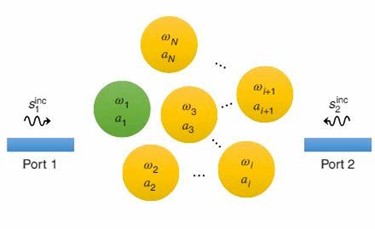Breaking Lorentz Reciprocity With Broadband Passive Isolators
By Jof Enriquez, Follow me on Twitter @jofenriq

Physicists at the University of Texas at Austin and City University of New York have developed a fully passive isolator consisting of coupled nonlinear resonators to propagate microwaves over a broad bandwidth. The design could be transferred to optical applications, as well.
Most electronic and photonic structures follow a fundamental characteristic called Lorentz reciprocity, which require waves to travel the same way for both forward and reverse directions. Lorentz reciprocity, because it transmits signals in both directions, can inject noise into circuits and damage devices such as lasers. Scientists know that breaking reciprocity and symmetry by manipulating waves could result in more stable, scalable, and broadband non-reciprocal circuits and devices.
A typical method to breaking Lorentz reciprocity in radar microwave transmitters is by using an external magnetic field, which require greater power consumption. Nonmagnetic alternatives can do the same job, albeit with far less efficiency. For instance, a single nonlinear resonator – a common feature of nonlinear isolators – must sacrifice transmission efficiency to transmit over a broad bandwidth.
Presenting a unique solution, a team of scientists from UT Austin and CUNY propose multiple nonlinear resonators combined in an isolator with a peak transmission frequency that changes in response to the signal itself.
"You can realize a device that, excited from one side, concentrates most of the field in one element and reflects it back but, excited from the other side, has the field in both elements and can transmit," said Andrea Alù, a professor at the Department of Electrical and Computer Engineering at UT Austin, in a Physics World article.
The team’s demonstration of their device in operation resulted in much better performance compared to isolators with single nonlinear resonator.
"We theoretically show, and then experimentally demonstrate using a microwave circuit, that the combination of one Fano and one Lorentzian nonlinear resonator, and a suitable delay line between them, can provide unitary transmission, infinite isolation, broad bandwidth and broad isolation intensity range," wrote Alù and co-authors Dimitrios L. Sounas and Jason Soric in Nature Electronics.
"We also show that a larger number of resonators can be used to further increase the isolation intensity range without diminishing the other metrics of the device," they added.
The device works at microwave frequencies, but can be applied to optical applications, as well.
"We are working on an experiment in optics now where we stack two patterned surfaces of silicon – which is a nonlinear material – with a certain separation," said Alù. "That structure would work as a mirror from one side and a transparent wall from the other, and it's fully passive."
